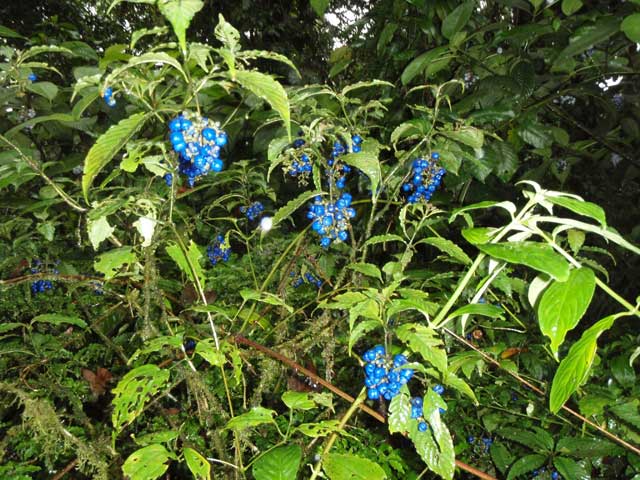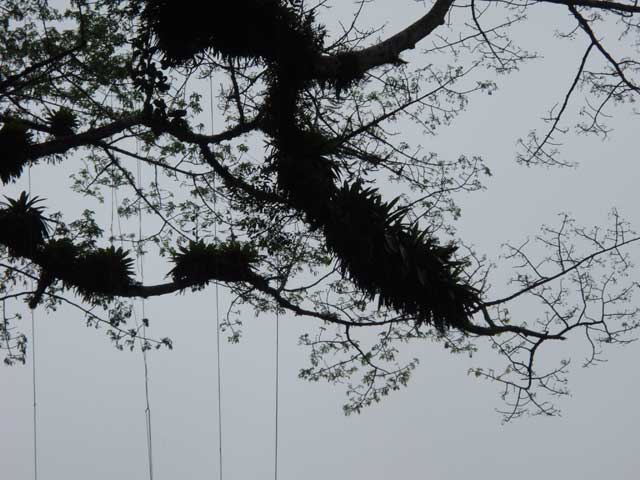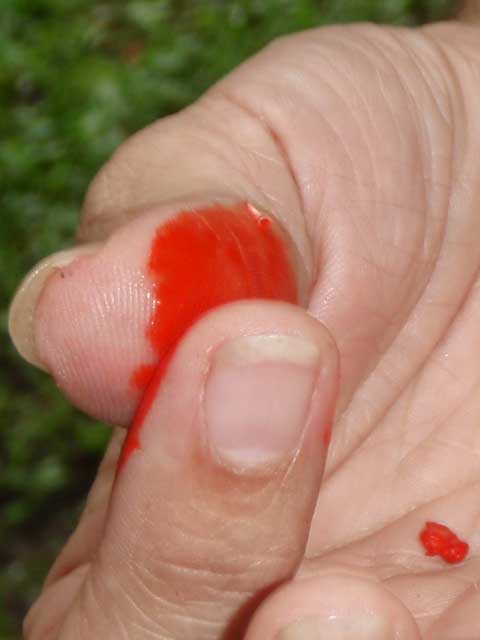
Psychotria - a coffee relative.

The first walk on the 20th started at 0615 before breakfast and took us through the rain forest.
Being a tropical rainforest, it rained.
Heavily.
I wore my rain jacket which, despite being water resistant, soaked through. I also used my umbrella to help keep the water off.
After going a goodly way through the rainforest, we entered a pine forest that was the result of deliberate planting – the trees are used for lumber, but unlike New Zealand, these pines are not invasive here. We followed a bike path to the bottom of the slope and crossed a suspension bridge into farmland where the trail continued to the road back to the lodge. Along the way we heard a long sequence of eruptions, which included “whooshing” noises, which we found out later was steam escaping the volcano. (Did I mention that the lodge is two miles from the peak of the mountain?)
I was using the waterproof camera that we bought for the New Zealand trip, but unfortunately the steady precipitation was preventing Jonathan from using his big camera much to his frustration.
Following the road back to the lodge, we took a different path to the restaurant by the swimming pool that went over another suspension footbridge, which made me glad we hadn’t come this way the night before.
After a hearty breakfast (you notice Country Walkers is living up to its nickname of “Country Eaters”), we gathered our rain gear along with the hiking gear to meet back at the reception area. When we got there we had the treat of coati mundi (two of them) on the deck outside the restaurant. These raccoon relatives lived up to that association and were looking for hand-outs and weren’t all that frightened of the humans taking pictures of them. We spotted another coati as we left the grounds of the lodge on the bus.
The morning’s walk was on the Silencio Farm. The rain continued, sometimes heavy, sometimes light, as we climbed into the hillside covered with rainforest. We passed an anthill of leafcutter ants who were displaying the good sense to stay inside their nest. The trail climbed up and up the slope, with occasional descents, until we reached the top of the ridge that overlooked the path of one the flows from the 1968 eruption of the Arenal volcano.
The affected landscape was covered primarily with some trees forty years later. Earlier, on the bus ride down from the lodge, Leo pointed out a stretch of the road where high grass/cane reached about twelve feet in height and there was little diversity of species that was seen in unaffected areas. That length of road was crossing one of the flows or lahars from the volcano, and because the ashes and cinders were not very fertile, only limited species can grow there. We eventually walked up to an area that overlooked the location of one of the towns that was wiped out by a pyroclastic flow in the 1968 eruption, although we couldn’t get close enough to the edge to see the actual site of the village.
Lunch was at the farm and restaurant of Don Juan where all the produce was grown on the farm. The restaurant, also in the open-air format, overlooked a lively stream and we ate under the awning as the rain fell. The menu served buffet-style included tilapia, cassava chips, potatoes, a vegetable medley that included water squash, with rice pudding as dessert. After lunch, Leo showed us around the farm where the crops are grown pointing out some of the less familiar crops, including annatto (lipstick tree), banana, chocolate (cocoa), and coffee. We walked a little way back to where the road crossed the stream, there we looked unsuccessfully for a basilisk in the creek.
After lunch, we stopped in the town of Fortuna to look around and maybe buy a souvenir. Armed with a twenty borrowed from Neal (as we left our wallets in the safe in the room), we prowled through a number of shops looking for a refrigerator magnet. Unfortunately for La Fortuna, none of the stock appealed to me, so we returned the twenty to Neal with our thanks. We then bussed back towards our lodge, stopping at the EcoThermal Hot Springs Resort. Judy, Neal, Jonathan and I took advantage of the resources, so the four of us ended up soaking the pains of the road away in the pools of the hot springs, sipping guava sours. Sean, Lin, and Joan entertained themselves at the bar in the reception area. After getting suitably and thoroughly waterlogged, we changed into dry clothes. Just before we left, a spectacled owl was spotted off the path to the pools. It was a rather large owl, one of the few that are active in day time.
On the ride back to the lodge, a few cars were stopped with people looking up into the trees. In this area, that could only mean monkeys. So we stopped, and sure enough, there was a troop of howler monkeys browsing the young leaves in the canopy. We took a few snaps and returned to the lodge for dinner. Jonathan and I immediately headed to the bar to try to catch up on our journals. At the bar, as the light was fading, I tried to get a snap or two of the magnificent vistas between the rain and twilight. I didn’t get much, except when I looked to my right on the walkway, a coati was looking at me for an easy snack. So I took a couple of pictures of the critter before returning to the bar to order a bottle of wine and begin writing.

Crushing the seeds release the intense color. This is the coloring that gives cheese its orange color.
Later that night, I was awakened by Jonathan commanding: “KING WAKE UP”. I knew it wasn’t time to get up for the pre-breakfast walk so my reply was a rather surly “Why?” To which Jonathan replied – “Look at the mountain” – I did and replied “Holy ****.”
The clouds had cleared enough that I could make out the outline of Arenal and fanning down the sides of the peak was a glittering lacework of red lines covering about one quarter to one third of the face of the volcano. All this was accompanied by the sound effects we had heard on our walks in the area, as the volcano spewed glowing rocks of lava down its side. The noise lasts about 15-45 seconds, while the red glow faded in about sixty seconds. We watched this from our beds, until the weather again closed around the peak, and the only evidence of the activity was the occasional ratchet of noise through the misty nighttime air.
I would have tried for a photo, but there was a single streetlight on the grounds of the lodge between us and the mountain that would have washed out the image.